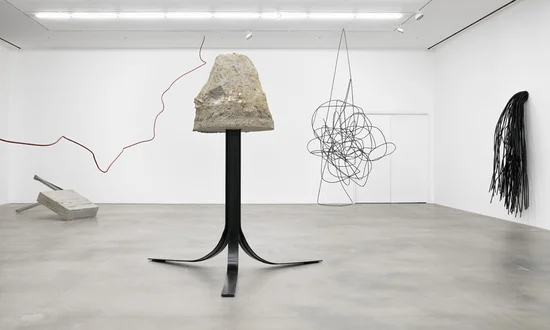Art is a language. When you encounter Monika Sosnowska’s artworks in her show Structural Exercises at Hauser & Wirth, the language is muscular and strong. Coming from the exuberance of the Oxford Street lights, the shops of Mayfair with their shiny windows drawing you in, Sosnowska’s sculptures confront you in their simplicity, of material and form. It is like walking home after a few celebratory drinks and cheer and coming to your senses in the stark, cold night.
This is Sosnowska’s first show with Hauser & Wirth, but she has been on a steady path for some time now. Born in Poland, Sosnowska first received international renown with her intervention ‘Corridor’ at the Venice Biennale in 2003, showed at the Serpentine Gallery, London in 2005, and has had many exhibitions in the United States.
Structural Exercises consists of seven sculptural works that together form an immersive exhibition taking over H&W’s North Gallery. Sosnowska has always worked in sculpture, but is particularly drawn to its architectural potential. She uses core materials that are closely associated with construction, such as concrete, steel beams, pipes, and rods.
Monika Sosnowska, Rebar 16, 2017
In the middle of the gallery, H and Concrete consists of a vertical black metal pole holding a triangular shape made out of concrete. It looks like some sort of urban tree. The heavy top weighing on the thin support is delicate, yet the sculpture comes across as sturdy. As if it has stood here over time, weathering winds and rain. In an opposite corner hangs Rebar 16, made of steel tubes that are sprouting out of the wall, like a wild growth. Within her individual works, Sosnowska cleverly plays with the contrast between the heaviness of materials and an elegance of forms.
There is also a fluidity between the works - Sosnowska's installations are always more than its parts. Dividing the space of the gallery horizontally is a Rebar 20, a wiry, red line, like a doodle in space. Appearing light and insignificant at a distance, we can see in close-up that it is made of metal. It forms a narrative connecting all the other works. Encountering the installation is like walking through a city; one that initially resembles any industrialized urban neighbourhood, but on closer look contains something more. There is a playfulness and an originality here. Sosnowska’s city is fantastical, a fairytale land made of the concrete base of our cities.
Monika Sosnowska, H and Concrete, with (left) Rebar 20 and (right) Rebar 12, all 2017
Like literature, art is often most powerful when it involves a certain ambiguity and openness, and when it is able to form new connections in our mind. This is Sosnowska’s strength. Her forms are experimental and psychological - she calls on her individual memories as well as on the collective experiences of the viewers. Her language is not merely one of sturdy concrete, but also an architecture of emotion and imagination.
Urban construction mixed with architectural fantasy. Sosnowska grew up in a rapidly transforming Warsaw, which in the 1960s was abound with modernist architecture aspiring to the new socialist order. When Sosnowska came of age in the 1980s, this order was again being replaced by the new developments of capitalism. Construction and deconstruction are in the fabric of Sosnowska's past.
It is important not to forget the strong social side of Sosnowska's practice: I believe that there is a message hidden in the steel forests. With ever-increasing population density, urban planning is becoming more precarious every day. Sosnowska seems to hand us a toolkit for how to open our eyes, our minds, and our horizons, how to dream wild. She seems to say that living with architecture can be functional and enhance our spirits. Architects and urban planners: take note. Everyone else, just allow yourself to wander freely in her world made of steel, made of stone. What a feeling!



